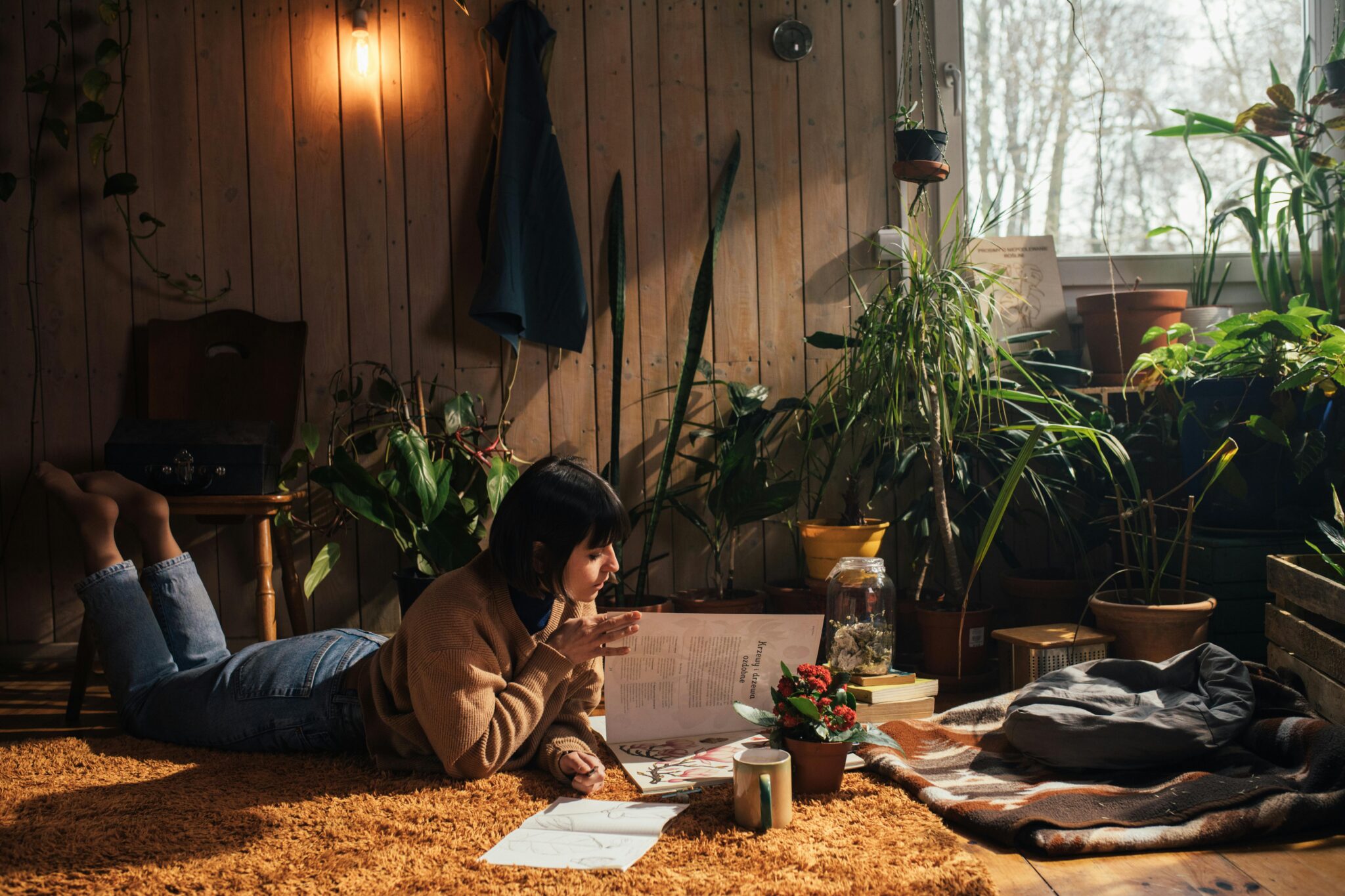
Plants don’t just bring life into your home—they can transform it. They purify the air, boost your mood, and add beauty to your space. Whether you’re looking to create a calming retreat or simply liven up a bland corner, filling your home with greenery is a rewarding way to upgrade your living environment. Let’s explore why plants are a must-have for your home, how to choose the perfect ones, and simple ways to keep them thriving.
The Benefits of Adding Plants to Your Home
Incorporating plants into your home isn’t just about aesthetics—it’s about transforming your space into a healthier and more inviting environment. Beyond their visual appeal, houseplants offer tangible perks that can enhance your well-being. Let’s break down some of the key benefits you can enjoy when you bring greenery indoors.
Improved Air Quality
Houseplants are nature’s built-in air purifiers. Through photosynthesis, plants absorb carbon dioxide and release oxygen, which helps replenish the air in your home. On top of that, certain plants can filter out common toxins found in household products, such as formaldehyde, benzene, and ammonia. For example, snake plants and peace lilies are known for their ability to clean the air effectively.
Imagine your home as a bubble, and each plant acts as a mini filtration system, quietly working to remove impurities you might not even notice. Cleaner air doesn’t just smell better—it can also help reduce allergies, improve focus, and promote better sleep. Just adding a few plants to your bedroom or living room can make a difference you’ll actually feel.
Enhanced Mood and Reduced Stress
Did you know that just being around plants can boost your mood? Studies have shown that indoor plants can reduce stress, increase happiness, and even lower blood pressure. There’s something calming about seeing greenery in your environment—it taps into our innate connection with nature.
Think about the last time you walked through a garden or hiked in the woods. Now imagine bringing that sense of peace into your home. Whether it’s a leafy monstera in your living room or a small succulent on your desk, plants create a calming presence. Plus, taking care of them can be therapeutic. Watering, pruning, and watching your plants grow can feel surprisingly rewarding, almost like a form of mindfulness.
Interior Design Appeal
From sleek modern spaces to cozy boho vibes, plants fit into any design style. They’re like a finishing touch that pulls a room together, adding depth and personality to areas that might otherwise feel flat or boring. Want to make a statement? Go for big, bold plants like fiddle-leaf figs or rubber trees. Prefer something subtle? Sprinkle smaller plants like pothos or ferns around shelves and tables.
Plants also add color and texture that softens harsh lines or stark spaces. A trailing ivy cascading down a bookshelf or a vibrant calathea with its striking leaf patterns can instantly elevate the vibe of any room. Plus, they’re versatile—you can hang them, place them on stands, or use them to fill empty corners.
Whether you’re a minimalist, a maximalist, or somewhere in between, plants adapt to your style effortlessly. They’re not just decorations; they’re living elements of design that evolve alongside your home
Choosing the Right Plants for Your Space
Adding plants to your home is exciting, but it’s not always as simple as picking the prettiest one at the store. The key to success lies in choosing plants that will thrive in your specific environment. Matching the right plant to the right spot means fewer headaches and happier greenery. Let’s break it down step by step.
Assessing Your Space
Before picking plants, take a close look at your space. Plants aren’t one-size-fits-all, so understanding your home’s unique conditions is essential. Start by evaluating three key factors:
- Light Availability: Notice how sunlight moves through your home. Do certain rooms get bright, direct light, or are they mostly shaded? South-facing windows typically provide the most sun, while north-facing ones are better for low-light plants. If you have limited natural light, consider adding grow lights.
- Temperature: Most houseplants enjoy stable temperatures between 65-75°F. Avoid placing plants near drafts, heaters, or air conditioners, as sudden temperature changes can stress them out.
- Humidity: Some plants, like ferns, thrive in high humidity (like your bathroom), while others, like succulents, prefer drier air. If your home feels dry, a small humidifier can help create a better environment for humidity-loving plants.
Taking the time to assess these factors will save you from frustration later. It’s like matchmaking—finding the right plant for your specific space ensures a happy relationship.
Low-Maintenance Plant Options
If you are just getting started or tend to have a “black thumb,” no worries. Some plants are nearly impossible to kill and require minimal effort to thrive. Here are a few beginner-friendly options:
- Pothos: This trailing vine can grow just about anywhere. It tolerates low light and bounces back quickly if you forget to water it.
- Snake Plant: Sometimes called “mother-in-law’s tongue,” this hardy plant survives in poor light and only needs occasional watering.
- ZZ Plant: Known for its waxy, deep green leaves, the ZZ plant thrives on neglect. It’s drought-tolerant and can handle dim lighting with ease.
These plants are perfect for anyone who loves the idea of plants but doesn’t have the time—or memory—to tend to them regularly.
Pet-Friendly Plants
Sharing your home with pets adds an extra layer of consideration when choosing plants. Many common houseplants can be toxic to cats and dogs if ingested. Luckily, there are safe options that won’t harm your furry friends:
- Areca Palm: A statement plant with feathery fronds, the areca palm is non-toxic and great for filling large spaces.
- Spider Plant: Known for its spiky, arching leaves, this plant is not only safe for pets but also easy to grow. Plus, its babies (“spiderettes”) can be propagated to create even more plants.
- Calathea: With striking patterns on its leaves, calathea brings beauty and is gentle for pets.
Always double-check a plant’s pet safety status before bringing it home, especially if you have curious animals that like to nibble.
Plants That Thrive in Low Light
Not every home boasts sun-soaked windows, and that’s okay. Plenty of plants are adapted to thrive in dimmer spaces, making them perfect for darker corners or rooms with minimal sunlight. Consider these options:
- Ferns: Boston ferns, in particular, enjoy shady spots and bring a lush, tropical vibe to any room. Just keep them slightly moist.
- Peace Lily: This forgiving plant tolerates low light and even lets you know when it needs water by drooping slightly—talk about convenient.
- Cast Iron Plant: True to its name, the cast iron plant is practically indestructible. It can survive low light, low humidity, and even a bit of neglect.
With the right low-light options, you don’t have to sacrifice greenery just because your home isn’t flooded with sunlight.
Choosing plants based on your home’s conditions ensures they not only survive but thrive. When you find plants that fit your lifestyle and environment, caring for them feels less like a chore and more like an enjoyable part of your routine.
How to Incorporate Plants into Your Home Decor
Adding plants isn’t just about placing pots randomly around your house. Thoughtful arrangement can turn them into striking design elements.
Hanging and Vertical Garden Ideas
If you’re short on floor space, think vertically. Hanging pots, macrame plant hangers, or a vertical garden wall can turn a small apartment into an urban oasis. These solutions are great for kitchens, bathrooms, or anywhere you want greenery without taking up precious surfaces.
Using Plant Stands and Shelves
Plant stands and shelves not only keep your greenery organized but also create visual interest. A bamboo stand with multiple tiers can add height to a space, while a few small pots on a floating shelf can complement your favorite books or decor pieces.
Grouping Plants Together
Cluster plants of different heights, shapes, and textures for a natural look. Larger plants like monstera can anchor the group, while small succulents add detail. Grouping plants also creates micro-climates, helping them retain humidity and thrive together.
Seasonal Decor with Plants
Switch things up by incorporating seasonal vibes. Pair poinsettias with holiday decorations in winter, or use blooming plants like orchids in spring. Adding nature-inspired seasonal touches can refresh your space year-round.
Caring for Your Indoor Plants
Healthy plants add joy to your home, but they need the right care. Here’s how to keep your greenery in good shape.
Watering and Drainage Tips
Overwatering is one of the most common mistakes. Always check if the top inch of soil feels dry before watering. Use pots with drainage holes to prevent soggy roots, and avoid letting plants sit in standing water.
Using the Right Soil and Fertilizer
Not all plants thrive in the same soil. Succulents and cacti need well-draining soil, while tropical plants love nutrient-rich mixes. Fertilize once a month during growing seasons (spring and summer) to keep your plants thriving.
Dealing with Common Plant Problems
Yellowing leaves? Drooping stems? These could signal overwatering, underwatering, or pests. Inspect your plants regularly and adjust care as needed. For pests, try natural remedies like neem oil or soap sprays.
Repotting Plants
Plants outgrow their pots over time. If you notice roots poking out of the drainage holes or the plant seems cramped, it’s time to upgrade. Choose a pot that’s an inch or two larger in diameter to give your plant room to grow.
Sustainable Practices for Plant Lovers
Caring for plants doesn’t have to generate waste. Here are eco-friendly practices to make your indoor gardening greener.
Reusing Containers for Pots
Transform old jars, tins, or wooden boxes into unique planters. With a little creativity, everyday items can add charm to your greenery while reducing waste.
Propagating Plants at Home
Many plants can be grown from cuttings. Snip a healthy stem from a pothos, snake plant, or philodendron and place it in water. Once it develops roots, it’s ready to pot. It’s not just cost-effective but deeply satisfying to grow your own plants.
Composting for Healthier Soil
Homemade compost can give your plants a nutrient boost. Kitchen scraps like fruit and veggie peels can be turned into rich compost, cutting down on food waste and improving soil health.
Buying from Ethical and Local Sources
Support local nurseries or sustainable farms when purchasing plants. These sources often grow their plants responsibly, and you’ll get healthier greenery compared to large, mass-market retailers.
Conclusion
Adding plants to your home isn’t just about aesthetics—it’s about creating a healthier, happier space that creates the ambience of a living home. They clean the air, lift your mood, and make your home look stunning. Start small with a low-maintenance plant or go all out with a vertical garden. Remember, plant care is a journey, not a race. Every step, from choosing the right plant to watering it properly, connects you to nature in meaningful ways. It’s time to embrace greenery and let your home come alive.













Add comment